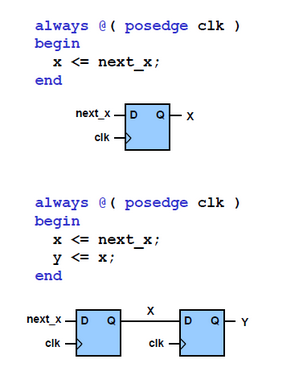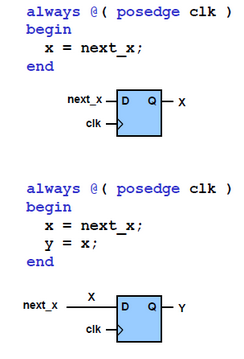sequential circuits
source : Lecture 7- Design of Digital Circuits
Blocking and non Blocking assignment
- the symbol ‘<=’ is used. It is known as a non-blocking statement, whereas in ‘assign’ statements, we use ‘=’ symbol called the blocking statement.
- In an ‘always’ block, if we use ‘=’ instead of ‘<=’, the compiler tool will complain.
- ’<=’ non-blocking statement, to indicate a register sequential circuit
- ’=’ blocking statement, to indicate a combinational circuit
Non-blocking (<=)
always @ (a)
begin
a <= 2’b01;
b <= a;
// all assignments are made here
// b is not (yet) 2’b01
end
- All assignments are made at the end of the block
- All assignments are made in parallel, process flow is not-blocked

Blocking (=)
always @ (a)
begin
a = 2’b01;
// a is 2’b01
b = a;
// b is now 2’b01 as well
end
- Each assignment is made immediately
- Process waits until the first assignment is complete, it blocks progress

Why use (Non)-Blocking Statements
- There are technical reasons why both are required
-
It is out of the scope of this course to discuss these
-
Blocking statements allow sequential descriptions, more like a programming language
- If the sensitivity list is correct, blocks with non-blocking statements will always evaluate to the same result
- This may require some additional iterations
Rules for Signal Assignment
1- Use always @(posedge clk) and non-blocking assignments (<=) to model synchronous sequential logic
always @ (posedge clk)
q <= d; // non-blocking
2- Use continuous assignments (assign) to model simple combinational logic.
assign y = a & b;
3- Use always @ (*) and blocking assignments (=) to model more complicated combinational logic.
4- You cannot make assignments to the same signal in more than one always block or in a continuous assignment
Notes
-
each of the ‘if’ or ‘else if’ statements would create a nested two input multiplexer and, thereby, slowing the system operation. From experience, we suggest that you don’t exceed four or five such nesting. Smaller
-
If you have many signal outputs (registers) in one sequential ‘always’ block, debugging the code will be a frustrating experience. It is, therefore, highly recommended that one should have only one register in one ‘always’ block pipelining
-
The logic must normally be put outside the always block using ‘assign’ statements for improving the speed of operation
`define S0 3'd0 // Define a macro
case(state)
`S0:
begin
//
end
default:
//
end // end case